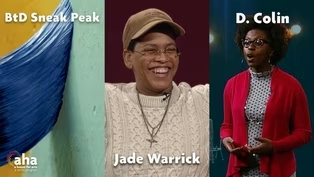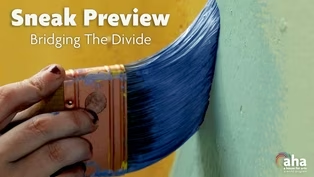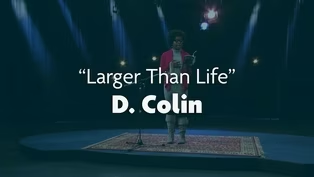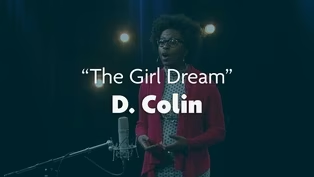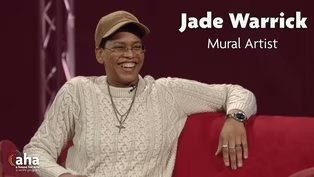
AHA! | 722
Season 7 Episode 22 | 26m 46sVideo has Closed Captions
A sneak peek of "Bridging the Divide," interview with artist Jade Warrick & a performance.
Get a sneak peek at "Bridging the Divide," artist Jade Warrick discusses the Hoosick Street Bridge mural project, and catch a performance from D. Colin on this week's episode of AHA! A House for Arts.
Problems playing video? | Closed Captioning Feedback
Problems playing video? | Closed Captioning Feedback
AHA! A House for Arts is a local public television program presented by WMHT
Support provided by M&T Bank, the Leo Cox Beach Philanthropic Foundation, and is also provided by contributors to the WMHT Venture Fund including Chet and Karen Opalka, Robert & Doris...

AHA! | 722
Season 7 Episode 22 | 26m 46sVideo has Closed Captions
Get a sneak peek at "Bridging the Divide," artist Jade Warrick discusses the Hoosick Street Bridge mural project, and catch a performance from D. Colin on this week's episode of AHA! A House for Arts.
Problems playing video? | Closed Captioning Feedback
How to Watch AHA! A House for Arts
AHA! A House for Arts is available to stream on pbs.org and the free PBS App, available on iPhone, Apple TV, Android TV, Android smartphones, Amazon Fire TV, Amazon Fire Tablet, Roku, Samsung Smart TV, and Vizio.
Providing Support for PBS.org
Learn Moreabout PBS online sponsorship(calm music) - [Lara] Get a sneak peek at WMHT's new documentary 'Bridging the Divide'.
Artist, Jade Warrick discusses the Hoosick Street Bridge mural project.
And catch a performance from D. Colin.
It's all ahead on this episode of AHA, A House for Arts.
- [Announcer] Funding for AHA has been provided by your contribution and by contributions to the WMHT Venture Fund.
Contributors include the Leo Cox Beach Philanthropic Foundation, Chet and Karen Opalka, Robert and Doris Fischer Malesardi, The Alexander and Marjorie Hover Foundation and The Robison Family Foundation.
- At M&T Bank, we understand that the vitality of our communities is crucial to our continued success.
That's why we take an active role in our community.
M&T Bank is pleased to support WMHT programming that highlights the arts, and we invite you to do the same.
(upbeat music) - Hi, I'm Lara Ayad.
And this is AHA, A House for Arts, a place for all things creative.
WMHT's newest documentary 'Bridging The Divide', chronicles the installation of murals under the Hoosick Street Bridge in Troy, New York.
The artwork is part of the Uniting Line Project, which aims to unite the community that was divided by the bridge's construction.
Here's a sneak peek at 'Bridging The Divide'.
- [Man 1] Every community has streets that are dividers.
- [James] Basically you turned a neighborhood into a highway, who does that?
- [Man 2] This is Hoosick Street.
This is a main street.
- [James] Once that bridge came, we became known as Hillside North.
- [Woman 1] We think of the bridge as the dividing line between North and South Troy.
And so we came up with the name "Uniting Line", just to be opposite of that.
- [Jade] When I'm doing public art, that is in a community that is not part of my own, I try really hard to connect with that community and to get their ideas so we can create a collaborative piece, so it's mine and theirs.
- [Woman 1] Will this public art project suddenly reunite the two halves of the city?
What it will do well is focus people's attention in a place where they haven't really paid attention in a long time.
(calm music) - First thing that came to mind when I was viewing the underpass pillars was like, oh my God, this is huge.
I was like, how am I gonna create characters that go across every single one?
Because it's not easy to create characters and items like that.
It's like you have to sit and think of faces and poses.
And I do use references sometimes, but it's like, how do you create something that's completely new and something that's completely, you know, just your own?
(calm music) The mural is basically showcasing BIPOC people in nature, surrounded by nature, which is calming and meditative for a lot of folks in the black and brown indigenous communities.
Just reveling in nature, enjoying and meditating in nature while also just enjoying their passions.
(calm music) There's a lot of love for boxing and basketball, were the two that stuck out to me the most.
Two images that you actually see repeated throughout this design is like a couple of basketball players and a couple of boxers is an ode to the folks who came out of Albany and became big basketball players or MMA or boxers.
- Again, North Central, the people who grew up there, and we have Kevin Pompey who was a professional boxer, Welterweight Champ.
He comes down and he trains the kids.
We've had some great basketball players come out of there.
Even my nephew, Emmanuel Maven, they called him "Tiki."
And he was like a step away from going into the NBA.
There was Luther Rackley who actually played in the NBA, played for the New York Knicks, Rosie Phillips, one of the best high school basketball players ever.
And he grew up on Ninth Street.
(calm music) - And when I spoke to KP and a couple of other people, they said that the neighborhood has a lot of soul to it.
And my interpretation of soul, which a lot of people kind of interpret, is could be music.
(calm music) We have the parents.
I think it's really important to show, like black fathers out there enjoying time with their kids, because it's something that happens, but unfortunately the stereotype that black fathers aren't present.
(calm music) We gotta showcase more art that has people of different tones of browns because it not only showing light skinned people and art really does affect the black community because you're kind of only seeing one tone as pretty and desirable.
And so I wanted to be very intentional about showing different shades of brown in this project.
We need to amplify the voices of people, my people, who feel like they aren't being seen.
(calm music) - Bridging The Divide premieres on February 17th at 7:30 p.m. and will be available online from that date forward.
Our studio guest tonight is Jade Warrick, the artist behind the "Uniting Line" mural.
I spoke with Jade to learn more about her design process and how art can be a catalyst for community healing.
Jade, welcome to A House for Arts.
It's such a pleasure to have you.
- It's a pleasure to be here.
(both laugh) - Now, I'm not alone in saying that the mural project you've created for the Hoosick Street Bridge in Troy is absolutely wonderful.
- [Jade] Thank you.
- And we'll come back to some of the inspiration and the designs that you created for that.
But first I wanted to ask you, did you always know that you wanted to be an artist?
- Oh yeah.
So, I've probably been, if you ask my mom, I've probably been into art and being artistic and just creative since I was probably five, since I was a little youngin.
And one of the things that really made me love being an artist and really diving into it was it brought me a lot of comfort.
It brought me a lot of comfort because it was just the place that I could go in that no one else could control.
Like I was like, this is my imaginary world.
- And you knew that from early on.
- Oh yeah.
'Cause I felt like I didn't know it at five, but I felt it.
And then when I was older, I was able to actually put some words and content to it.
But as a kid, I just always loved diving into it.
I loved coloring.
I was homeschooled, so I was kind of a little bit isolated, so it also brought me peace of mind , where I was like, oh, maybe I don't have as many friends, but at least I have my comic books and things like that.
So.. - So comic books then were like a big influence for you though.
- Oh, I loved comic books.
- Yeah.
- I've always loved graphic novels.
I've always loved reading when I was young.
So that was a huge inspiration.
And another thing that really made me dive into art is that I loved making other people feel good.
I liked being able to draw images or little comics or make up board games for my siblings.
And I would see how much joy it brought them.
I would see how I would release weekly comics in like, God, so many different characters.
And I would release a weekly newspaper, handmade by myself, and distribute it out.
- Like a traditional (indistinct) basically, yeah.
- Yes, I did (indistinct) - Yeah.
- So I would make like, you know, little homemade comics and games and even card games, we couldn't afford Pokemon cards, so I would make fake Pokemon cards, and we would just trade them within my siblings and family.
And I found how much joy that brought them.
And I was like, this is something that I want to do.
It not only bring some myself joy, but it also brings other people joy.
- [Lara] Right.
- And I like that feeling.
- So you learned from early on the importance of community and creativity and how those really connect together.
- [Jade] Yeah.
- Which then brings us to this Uniting the Line project that you're a part of and that you made these murals for the Hoosick Street Bridge.
Can you tell us, I know you said comic books were an inspiration for you, but how did you go about coming up with some of the designs, as well as the characters for these paintings?
- Yeah.
So, I'm huge into graphic art, cartoony art, illustrationary art.
I'm a huge comic book fan.
I got a few, if you were to go to my house, you see my shelves just full of single issues, volumes, all that.
- Do you have any favorites?
- Oh yeah.
So, Saga, Y: The Last Man, Paper Girls, pretty much anything, Brian K. Vaughan, I'm a fan of.
And then I like a lot of Monga, like Berserk, I think Asana and a few others.
- [Lara] Wow.
- The list goes on, to be honest.
- [Lara] Yeah, yeah.
- And I like a lot of, more dark horror Monga as well.
- Right, right.
- Yeah.
It's just super, from like cute fun stuff, all the way to super dark, crazy things.
I've always (indistinct).
- But we don't see a lot of dark and crazy on the Hoosick Street Bridge murals, right?
It's a lot more fun.
- It's a lot more fun.
- But how did you go about creating these?
- So with that, I really thought it was important to have the community involved.
And so did the Capital Region Art Center as well.
So the process for this was to get the community involved and see what they want.
Now, I believe there were three finalists and then the community got a choice to look at all of our images and all of our designs and decide which ones they connected with.
My original submission was kind of a concept.
It was like, these are not what you're gonna see out here, but this is what I wanna put.
I wanna make sure that there's nature.
I wanna make sure that there are people of color who are enjoying themselves and (indistinct) happy and there's really no political side to it.
It's just black people and brown people just being happy in nature.
- [Lara] Right.
- That's all I wanted to showcase.
- Yeah.
Cause you've got flowers and you've got these characters, right?
- Yeah.
I think that's so important.
An ancestral past, like nature is a huge connection for a lot of people of color.
And I just wanted to see more art with people of color involved with nature.
You'll see that as a theme of a lot of my murals, a lot of my murals revolve around people of color, surrounded by art.
- Yeah.
- So, I spoke to some community members around Troy and I asked them, what do you wanna see?
What brings you joy about your neighborhood?
What brings you joy about your community?
What are you prideful about?
What type of characters do you wanna see to relate to?
How do you feel seen?
How can I make you feel seen?
- And what are one or two things you kept seeing over and over again when people answered?
- People said soul, there was a lot of soul.
They're like, there's, Troy's has a lot of soul, like you don't even know how much soul it has.
And I was like, whoa, do tell.
And then another one was a lot of community.
There is a lot of community involved in it.
When I heard that, I was asking them, okay, well when you say community, what does that mean?
And that's where I found out.
I spoke to KP, who runs a lot of programming at the basketball court, and he was saying like, we do so many community programs here for the kids, the youth find this a safe space.
They come here when they need to blow off steam.
There's a lot of MMA fighters and boxers from the area.
So that's also a piece of the community.
- [Lara] Right.
- There's a lot of artists from the area.
So that, I think we all know there's a ton of artists in Troy.
- [Lara] Yes.
- So that's a piece of the community as well.
And artists, I don't just mean visual artists, I mean, musicians, writers, poets, - [Lara] All different creative industries.
- All type of different creative industries.
- And it's so great, Jade, that you asked people in the area, what does community mean to you?
- [Jade] Yes.
- It really shows this incredible collaboration in this back and forth.
And I actually wanted to, I think in order for us to understand just how important it is, the role that your mural project is playing there.
We're gonna cut to hear a story by one long time resident about the impact that the building of the Hoosick Street Bridge has had on his life.
(soft music) - Myself, I've been living in Hillside North since the age of seven years old.
(calm music) After coming back from college, I went into the Marine Corps.
I was in Japan.
And when I came home and was leaving the airport, I was like, what is this?
(calm music) That's when they separated Troy.
We became known as Hillside North.
So we're almost like we're not a part of Troy, we're part of something else, another entity.
There were homes there, there was stores, there was a pizza place on the corner.
There were diners.
All that's gone.
That changes a community, that really changes a community, you know, there's good change, and then there's bad change.
And that bridge has been a bad change, at least for Hillside North residents.
(calm music) - Good morning to you, sir.
- Just a generalized question.
Did you like this area before that bridge or when that bridge came, did it make a change?
- A whole bit of change, you know that.
All the traffic and everything.
- [James] (indistinct) the traffic.
- Yeah.
I don't even like, I used to walk (indistinct).
Even (indistinct), that street was terrible.
- Terrible.
(calm music) I don't think they ever even looked at how was the people who used to normally walk across the street, get across the street.
You don't put a highway in a community.
(calm music) We had a lot of new renters and a couple of homeowners.
It's not the same pride.
It's not the same family type, but it's getting better.
It's getting better.
(calm music) You might come across North Central and you'll see these boxes or flower boxes.
And every year people have their flowers out and then we come by and take pictures.
And then we have, during National Night Out, the best flower setting.
And so, it kind of beautifies the neighborhood and we have more every year.
So that's an other way of North Central taking pride in just where we grew up.
(calm music) - [Woman 2] The artwork is, oh, lovely.
- [Woman 3] Oh, that's nice.
Very nice.
- It's really nice.
You kind of love it when you go by.
It gives a little uplift (indistinct) air.
- As far as the mural coming up on all those stands from the bridge, that is super.
It makes you feel part of a community instead of like graffiti, you know, like somebody cares.
Not just we care, but somebody else cares about how we are coming up or raising our children down here.
So we take a sense of pride in that.
(calm music) I feel great about this, I mean, I grew up here and I think every neighborhood's gonna have a little trouble, but we're trying to even downsize that, you know, and the help of the whole community will be fine.
(calm music) - I would love to know from you, Jade, what kind of role do you think your work on the mural project, what do you think it does to address this sense of alienation that many longtime residents feel?
- So, I do believe that the bridge is just a stitch in the wound.
It's not gonna, not the bridge, but the art that's on the bridge.
I don't believe that it's going to just solve everyone's problems, you know.
We have this beautiful art up here, that's one step.
I think that's more of a spotlight on the neighborhood that could hopefully have a domino effect.
So I've heard a lot about how folks feel a little bit unsafe.
Actually, folks feel a lot unsafe.
- And you feel unsafe because of walking under the bridge, is that what it is?
- Yeah, there's no light, there's a giant bridge there, there could be, you know, more crime in that area.
So folks, I've heard in the neighborhood, people don't feel safe walking there.
They don't feel safe staying at the bus stop.
There's a bus stop right under, near one of the columns.
- Right.
- So, I've heard that a lot.
I've heard that they also don't really find it very pretty, now they do, like now they're like, okay, now we have some color now, it's bright, but that's, again, I think that's only just one part of the solution.
I think that there needs to be maybe more access to nature out there.
Maybe, there's that giant, I think sandpit or something out there, like what are we doing with that?
Like, there's just a giant plot of dirt.
How can we fix that?
How can we address that to make that a space where people can have picnics at, where they could read to their children, where they could just sit there and just enjoy their space.
How can we get lighting out there so it doesn't feel so dark?
So if you're alone and you're walking at night, you don't feel like your hairs on your back are standing up.
- It really sounds like you've captured the admiration of so many members of the local community to the extent that we've actually had audience members send in some questions that they wanted to ask you.
- Really?
- So I'm gonna go ahead and ask two questions sent in by viewers and by listeners.
So, the first one, the first question's from DJ Hollywood and he asks, what were some adversities that you faced with a project this big and impactful and how did you overcome them?
- All right.
Shout out, DJ Hollywood.
So, I guess he's asking what did I find challenging about this project?
- [Lara] Yeah.
- Okay.
So I guess for this project, I would say most likely communication, this project was a huge scale project.
It's, I think, it's one of the largest murals in upstate New York.
I'm not a hundred percent sure, but I'm pretty sure 'cause folks have told me that, who run a lot of the art organizations and I feel like they should know.
So, I would say communication with such a large team.
So I'm like the art director.
- How many people did you have on your team roughly?
- Probably about 10 or plus, 10 plus.
- Right, yeah, that's a pretty big team.
And so you served as artistic director then?
- [Jade] Yes.
- So you were really being like a project manager on this.
- Yes, pretty much.
But even with that, it became difficult.
You know, you're working with a lot of artists.
Everyone has some like artistic ego, you know, sometimes communication can get a little bit mixed up.
So I found that really difficult, but I found it also a learning experience 'cause now I know, you know, next time I do a project of this scale, I now know to do things a little bit differently and maybe communicate more and not get so overwhelmed or intimidated sometimes as an artist myself, 'cause I'm younger in the game, I sometimes feel intimidated by artists who have 10, 20 years.
- [Lara] Right.
- Of experience than I do.
And sometimes I'll just shut down and just be like, you know what?
You have the experience, I'm gonna let my imposter syndrome hit right now.
And so now I know going forward, you know, I do know what I'm talking about.
I trust in my vision and I trust in myself.
- I wanted to ask you a question, this time by an anonymous viewer.
And so they ask, what will you take with you from this project to your next?
And what impact will this specific piece have on your career?
- Again, I think I will take learning to trust in myself and be more graceful with myself and just trust in my intuition and be better about communicating my wants and my needs.
Again, this is my first time, kind of like any type of management of a project this large.
So I just came in as a young whipper snapper.
So it's nice, now that I can go into my next project and not feel so new and inexperienced in it, I guess.
- Going in a seasoned veteran.
- Yes.
One year.
(both laugh) - One year as a seasoned veteran.
Well, Jade, it sounds like you're doing something really fantastic, not only for the community in Troy, but with the community in Troy, which I think is such an important distinction there.
So, I wanna thank you again for being on A House for Arts and for making such an incredible contribution.
- Thank You.
I appreciate it.
- Please welcome D. Colin.
- The Girl Dream.
And the girl called three boys into a room.
The girl, the only girl, and my grandpa asked what they wanted to be.
And the girl, bright eye, chest out, back straight, clear voice, said lawyer.
The girl made a river bed and dirt road, fried plantain and pikliz, coal fire and cast iron pot said, "lawyer."
Not two weeks later, my grandpa pulled the girl out of school, sent her to learn how to sew and cook.
The girl's supposed to be a boy's dream, not dream like one, not supposed to be lawyer, or big, or speak loud, or speak.
The girls skipped sewing class, used pocket change from (indistinct) so to buy fresco and watch people walk on (indistinct) without anyone knowing.
The girl, a protest, the girl still dreaming in view of the presidential palace.
The girl becomes a woman, becomes a wife, becomes my mother.
My mother carries three girls and a boy, like the tethered, like a reckoning.
I am the only child to survive the terrain of her womb.
The only girl, the only dream left.
My mother immigrant, my mother night school and wrestling Creole on her tongue, my mother lover of coconut flesh and peanut brittle, my mother loud, my mother sacrifice, my mother First Lady of the church, my mother housekeeper for a living, my mother a mathematician, making a dollar out of (indistinct), less than 15 cents.
And one day she taught me a lesson in a white woman's bathroom, pointed to the toilet she just cleaned, said, "this job in particular and overall is not for you", said you could be a lawyer, translation, be a lawyer, translation, does not matter that you are a girl, translation, I am her dream, carved out her stomach from her cooked hands, aged from fire and bleach, her back, a wall crumbling, her kidneys passing stones, the weights of all her deprivation, a field of hives on her skin, a sting piercing back.
Mrs. Large was a tall woman, broad shoulders, and a walk that could wake a room.
I was 11, little, shy, full of quiet, nothing of boom.
Sixth graders were afraid to make it to eighth grade because she was everything of boom.
Voices and blackboard and chalk, she knew how to write and erase fear in a child.
Mrs. Large was large, silenced a class just by looking and waiting.
She chilled in her power.
Cool as shaved ice on a summer day, cool as the gray on her head, she danced in her passion.
First teacher I ever met, who loved what she did.
I was 11, Mrs. Large asked my sixth grade teacher for the top of the class, that was me, the nerd, the bored kid.
She asked if I would write a speech for the school contest, then speak it out loud.
Me?
Little, shy, full of quiet.
No!
That was me.
Mrs. Large didn't take no for an answer.
She heard possibility.
She heard nothing of no and everything of boom.
Maybe once upon a time she was shy too.
She was after school, and pen, and paper, and grammar.
She was hope and ambition, and challenge.
First time I ever spoke in front of the school, I thought I would die, faint to no waking.
Mrs. Large said she was my audience.
She was large enough to fill the whole room.
She was the only one there.
She was stage, and mic, and front row.
I never told her.
I hope that she knows, I am writer because of her.
I am stage, and mic, and poet, and might, I am light on words because of her, the teacher who set the precedent, told me once I could be the first black woman president, and I believed her.
She gave me more than garens and definitions, more than verbs and sentence structure.
Most students had her for one year, I had her for three, working on speeches, working on me.
Mrs. Large was larger than life to me, until I was larger than life to myself.
(upbeat music) - Thanks for joining us.
For more about WMHT's new documentary premiering on February 17th at 7:30 p.m. head over to wmht.org/Bridging The Divide.
I'm Laura Ayad.
Thanks for watching.
(upbeat music) - [Announcer] Funding for AHA has been provided by your contribution and by contributions to the WMHT Venture Fund.
Contributors include, the Leo Cox Beach Philanthropic Foundation, Chet and Karen Opalka, Robert and Doris Fisher Malesardi, the Alexander and Marjorie Hover Foundation and The Robison Family Foundation.
- At M&T Bank, we understand that the vitality of our communities is crucial to our continued success.
That's why we take an active role in our community.
M&T Bank is pleased to support WMHT programming that highlights the arts and we invite you to do the same.
Video has Closed Captions
Preview: S7 Ep22 | 30s | A sneak peek of "Bridging the Divide," interview with artist Jade Warrick & a performance. (30s)
Bridging the Divide Sneak Preview
Video has Closed Captions
Clip: S7 Ep22 | 4m 12s | Get a sneak preview of WMHT's new documentary, "Bridging the Divide." (4m 12s)
Video has Closed Captions
Clip: S7 Ep22 | 2m 22s | D. Colin performs "Larger Than Life" at WMHT Studios. (2m 22s)
Video has Closed Captions
Clip: S7 Ep22 | 2m 16s | D. Colin performs "The Girl Dream" at WMHT Studios. (2m 16s)
Video has Closed Captions
Clip: S7 Ep22 | 14m 32s | Learn more about Jade's design process, & how art can be a catalyst for community healing. (14m 32s)
Providing Support for PBS.org
Learn Moreabout PBS online sponsorship

- Arts and Music

Innovative musicians from every genre perform live in the longest-running music series.












Support for PBS provided by:
AHA! A House for Arts is a local public television program presented by WMHT
Support provided by M&T Bank, the Leo Cox Beach Philanthropic Foundation, and is also provided by contributors to the WMHT Venture Fund including Chet and Karen Opalka, Robert & Doris...
